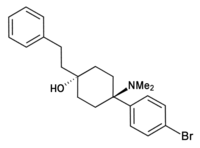BDPC
 | |
| Clinical data | |
|---|---|
| ATC code | None |
| Identifiers | |
| |
| CAS Number |
77239-98-6 70895-01-1 (HCl) |
| PubChem (CID) | 9887338 |
| ChemSpider |
26001358 |
| Chemical and physical data | |
| Formula | C22H28BrNO |
| Molar mass | 402.37 g/mol |
| 3D model (Jmol) | Interactive image |
| Melting point | 208 to 210 °C (406 to 410 °F) |
| |
| |
| (verify) | |
BDPC (systematic name 4-(4-bromophenyl)-4-(dimethylamino)-1-(2-phenylethyl)cyclohexanol; also known as bromadol) is a potent narcotic analgesic with a distinctive arylcyclohexylamine chemical structure. It was developed by Daniel Lednicer at Upjohn in the 1970s.[1] Initial studies estimated that it was around 10,000 times the strength of morphine in animal models.[2] However, later studies assigned a value of 504 times the potency of morphine for the more active trans-isomer.[3] To date, it is unknown if this drug has been used by humans, however, it was seized along with three kilograms of acetylfentanyl in an April 25, 2013 police action in Montreal, Canada. Despite taking precautions, at least two officers became intoxicated due to handling the drugs.[4]
Structure-activity relationships
Several related analogs such as the p-methyl and ring-unsubstituted compounds have also been investigated.[5] BDPC is the lead compound in this series that attracted so much interest in it initially. A large number of analogs have been prepared,[6][7] and the SAR is very well established. Lednicer constructed Dreiding models to show that the model of BDPC will give an exact overlay on a model of fentanyl.
-4-(dimethylamino)cyclohexan-1-one.png) 4-(4-methylphenyl)-4-(dimethylamino)cyclohexan-1-one | -4-(dimethylamino)cyclohexan-1-one.png) 4-(4-bromophenyl)-4-(dimethylamino)cyclohexan-1-one | Lednicer's two parent compounds for BDPC. They are equipotent, which is an unusual case for a simple cyclohexanone to display interchangeable equal potency with either a methyl or bromine in the same substitution, both having the same potency as pethidine.[8] The p-Methyl was never tested as an analogue of BDPC because 'We forgot'.[9] Although Lednicer stated that he felt that the p-Me would be equipotent. |
See also
References
- ↑ U.S. Patent 4,366,172 - 4-Amino-cyclohexanols, their pharmaceutical compositions and methods of use
- ↑ Lednicer, D.; Vonvoigtlander, P. F. (1979). "4-(p-Bromophenyl)-4-(dimethylamino)-1-phenethylcyclohexanol, an extremely potent representative of a new analgesic series". Journal of Medicinal Chemistry. 22 (10): 1157–1158. doi:10.1021/jm00196a001. PMID 513062.
- ↑ Liu, Z. H.; Jin, W. Q.; Dai, Q. Y.; Chen, X. J.; Zhang, H. P.; Chi, Z. Q. (2003). "Opioid activity of C8813, a novel and potent opioid analgesic". Life Sciences. 73 (2): 233–241. doi:10.1016/S0024-3205(03)00263-7. PMID 12738037.
- ↑ "Extremely potent painkiller hits Montreal black market". CBC News. May 13, 2013.
- ↑ Report 1985, 21 pages, from Foersvarets Forskningsanstalt, Umea, Sweden. (Report in Swedish)
- ↑ Lednicer, D.; Vonvoigtlander, P. F.; Emmert, D. E. (1981). "4-amino-4-arylcyclohexanones and their derivatives: a novel class of analgesics. 2. Modification of the carbonyl function". Journal of Medicinal Chemistry. 24 (4): 404–408. doi:10.1021/jm00136a010. PMID 7265128.
- ↑ Lednicer, D.; Von Voigtlander, P. F.; Emmert, D. E. (1981). "4-aryl-4-aminocyclohexanones and their derivatives, a novel class of analgesics. 3. M-Hydroxyphenyl derivates". Journal of Medicinal Chemistry. 24 (3): 341–346. doi:10.1021/jm00135a019. PMID 7265120.
- ↑ US Patent 4460604
- ↑ personal communication of Danial Lednicer